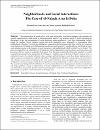Neighborhoods and Social Interactions: The Case of Al-Najada Area in Doha
| المؤلف | Eissa, Bassma |
| المؤلف | Awwad, Rana |
| المؤلف | Awwaad, Reem |
| المؤلف | Furlan, Raffaello |
| تاريخ الإتاحة | 2017-11-28T09:20:25Z |
| تاريخ النشر | 2015 |
| اسم المنشور | American Journal of Sociological Research |
| المعرّف | http://dx.doi.org/10.5923/j.sociology.20150504.03 |
| الاقتباس | Bassma Eissa , Rana Awwad , Reem Awwaad , Raffaello Furlan , Neighborhoods and Social Interactions: The Case of Al-Najada Area in Doha, American Journal of Sociological Research, Vol. 5 No. 4, 2015, pp. 119-133. doi: 10.5923/j.sociology.20150504.03. |
| الرقم المعياري الدولي للكتاب | 2166-5443 |
| الملخص | Cities provide places for people to live, work, learn and socialize. As urban environments, cities nowadays are typically characterized by urban sprawl in which open public spaces (1) are neglected and/or (2) social interactions are discouraged. In fact, the encouragement of social interactions among neighbors is a vital factor implementing livability among city dwellers. Recent evidence suggests that social interactions occur infrequently in contemporary urban neighborhoods. Therefore, it is worth investigating how communities can be designed in the future with the aim to increase social interactions. Al-Najada area in Doha provides a useful case study because it is a traditional area, built based on formal social structures aiming to the formation of social interaction in old neighborhoods (which is called Fereej in Arabic). This paper investigated how the urban fabric of Al-Najada area can be implemented in order to enhance social interactions and become an effective sample of sustainable development. Also, this paper examined the factors that contribute to socially sustainable development in the regeneration of Al-Najada as a traditional asset in the heart of Doha. Literature review is conducted on topics of sustainable urbanism, urban sociology, and built heritage to learn about design implementation in order to enhance social interactions within the urban fabric of neighborhoods. Therefore, content analysis, site observations, and walking tour assessments are adopted as the main research methods in order to investigate how social interactions at Al-Najada area can be encouraged, namely how the spatial form can be implemented in order to enhance social interactions. The research study findings led to the definition of a set of recommendations for a design approach, based on smart planning and design guidelines, aiming at implementing Al-Najada neighborhood in order to facilitate social interactions. The recommendations are genuinely plan-led, empowering local people to shape their surroundings, with concise neighborhood plans setting out a positive vision for the future of Al-Najada area. |
| اللغة | en |
| الناشر | Scientific & Academic Publishing |
| الموضوع | Sustainable Urbanism Social Interactions Al-Najada Doha Traditional Neighborhood |
| النوع | Article |
| الصفحات | 119-133 |
| رقم العدد | 4 |
| رقم المجلد | 5 |
| ESSN | 2166-5451 |
الملفات في هذه التسجيلة
هذه التسجيلة تظهر في المجموعات التالية
-
العمارة والتخطيط العمراني [307 items ]


